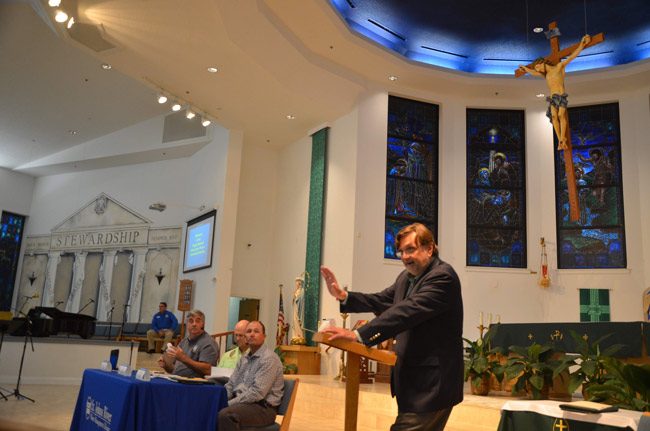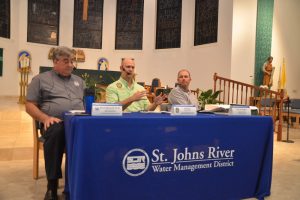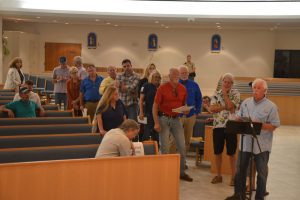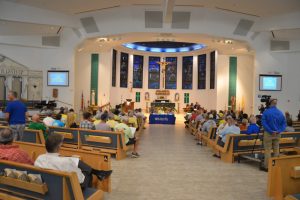
Last Updated: Friday, 11:51 a.m.
As it sees it, the St. Johns River Water Management District is trying hard to work with Flagler Beach residents and win them over to a planned $516,000 project to “restore” more than 110 acres of Intracoastal Waterway marshes at the south end of town to pre-1960s conditions. But it’s not working. Opposition to the project remains rife and at times bitter: “If it goes through, I hate you all,” one homeowner told district and project officials at a public meeting organized to win over residents Wednesday evening in Flagler Beach.
The restoration on public lands entails demolishing spoil piles and filling ditches that the U.S. Army Corps of Engineers and mosquito officials built decades ago, demolishing wetlands in what proved to be a catastrophic approach to mosquito control. As with much similar re-engineering of nature, it took years for officials to concede that they’d erred. The error led to a progressive erosion of wetlands and a subversion of coastal species, to the detriment of native vegetation and fish.
The water management district is now proposing to again re-engineer nature, if only to bring it back to its original state, or something like it. It would be re-demolishing what was once demolished and rebuilt. That’s making residents nervous. The theoretical data behind the plan is limpid as crystalline waters: district officials say that’s the way to restore wetlands, make them more sustainable in the long run and more effective buffers against erosion and storms. The factual data, however, is scant, and the anecdotal data, judging from claims by Flagler Beach residents and fishermen, contradicts rosy projections by district and fish and wildlife officials.
The district wasn’t going to do any outreach to what it calls “stakeholders” in the project. Its administration was forced to hold two public meetings to hear residents’ concerns only after those opponents flooded a district meeting’s chambers on Sept. 11, halting the district board from taking a final vote that would have kicked the project forward. The board did vote to proceed, but with caveats that left final approval of the contract conditional on the outcome of public meetings.

Now the board must contend with the fact that the district’s brief attempt at outreach hasn’t mollified the opposition. Residents are not biting. Three district board members were present to see the opposition for themselves Wednesday night at Santa Maria del Mar church in Flagler Beach: Board Chairman John Miklos, Alan Roberts and Chuck Drake. Roberts had been the board’s most skeptical, questioning member at the Sept. 11 meeting.
They did not hear anything too different than what they heard at that district board meeting, though the district made two significant adjustments to the project: it would move its boundary a greater distance from residents’ properties, and it would ensure that certain fishing zones and lanes are untouched.
The board also brought back its trio of project point men–the same trio that had presented the project to the Flagler County Commission on Sept. 17–to patiently answer written questions for 90 minutes: Erich Marzolf, the St. Johns Water Management District’s division of water and land resources, Jeff Beal of the Marine/Estuarine Subsection of the Florida Fish and Wildlife Commission, and Chris Schlageter, an ecologist and president of Old Florida Conservation, Ecological project manager. They did so with environmental attorney Clay Henderson, the meeting’s moderator, standing beneath a looming, crucified Christ in front of the sanctuary. (The church offered its venue when Flagler Beach City Hall proved too small after the first public meeting on Oct. 4. “Personally I’m grateful that the roof hasn’t fallen in,” Henderson said at the beginning of the meeting in a nod to the crucified. “This is a new experience for me.” Henderson is the director of the Institute for Water and Environmental Resilience at Stetson University.)

The trio spoke of planned monitoring of water turbidity and quality during construction with a massive excavator, but Marzolf also conceded that monitoring for species regeneration takes “years if not decade.” Beal spoke of the loss of wetlands around the world and the urgency of repairing them. Schlageter spoke of the necessity of toppling mangroves and other vegetation, some of it non-native, on the way to regenerating the acreage, promising “we’ll actually have a net gain” in species as a result. They all spoke in terms of “recolonization, said there’s been no evidence of DDT in the soil–though a test was done only this week, and results won’t be ready until later this month. And when questioned why there’s been no environmental impact statement, Marzolf said it wasn’t necessary: permitting was thorough enough.
That did not sit well with members of the audience, some of whom later lambasted that approach.
The 90 minutes of answers did not sway opinions, which nevertheless seemed hardened regardless, the texts of opponents’ speeches already drafted and ready to be read from their iPhones or printouts.
They see the two public meetings the district set up to hear input and win over public support as belated and insufficiently responsive to their questions. The first such meeting didn’t even include a question and answer period. It was more of a town hall-like meeting where people could speak with district and other officials individually.
At the end of Wednesday’s second public meeting, which had both a Q&A and a public-input period, opinions among the more than a dozen people who spoke was near-unanimous: residents don’t want the project. Fishermen don’t want the project. Neither group is finding the district or Florida Fish and Wildlife Conservation Commission explanations satisfactory enough, even though they’re the same explanations that have undergirded the restoration of upwards of 600 such acres along the coast.

“We have asked. How’s the fishing, how’s the habitat?” Matt Hathaway, who has led opposition to the project with his wife Elizabeth, told district officials Wednesday evening, referring to queries to people in other regions that have gone through such restorations. “Did it recover the way they said? What’s going on? And I’m looking for honest answers, and we’re getting negative responses, negative responses. The fishing is destroyed, habitat is destroyed, didn’t come back, water quality is gone bad. So our fear is based on others’ experience. That’s why we’re here.”
Hathaway then asked for the more than 100 people gathered at Santa Maria del Mar Catholic Church for those opposed to the project to raise their hand. Most did. “And that’s it. I mean, the stakeholders are speaking, the stakeholders are here, the community has spoken.” He said the community should want to embrace the project. But “nobody in Flagler Beach wants it. As simple as that.” He may have been overplaying the case somewhat: the Flagler Beach City Commission twice discussed the matter then declined to take a position. The land in question is not in the city limits, and though it did not say so explicitly, the city, like the county, may not have wanted to antagonize the district, whose grants it seeks annually.
And while opponents Wednesday were significantly more numerous than advocates of the project (officials aside), advocates were not silent, either. (An earlier version of this story failed to more accurately reflect those voices.)
Paul Haydt, president of the Friends of Gamble Rogers State Park, who formerly worked with the management district, referred to wetlands restoration projects in Volusia County, one of them starting 30 years ago, that have since benefited from the expertise of bird, fish and other species specialists to refine the restoration method. “It worked well, good for habitat, good for water quality,” he said. “We need more salt marshes.”
Lynn Flannery, a Flagler County resident who described herself as an “environmental professional,” also lent her voice in support of the project, crediting the scientists involved in the project with the wherewithal to ensure that “everything comes out correctly.” She added: “Every day when I drive around and I see the continued construction, it concerns me. Each acre that becomes a home means more herbicide, more pesticide, maybe another septic tank, and we keep causing more harm to mother nature, and I know we can’t stop the development. But this is our opportunity to do something in the right direction, giving back to mother nature.”
Bill Praus, who lives near the restoration project and says he’s fished the affected waters for six decades, added his voice in support of the project, questioning critics “voicing their concerns about the project where they have ulterior motives, like they’re thinking of just themselves or how this is going to impact their property values. You’ve got to look beyond that, folks. You just got to. You’ve got to look at this planet as being our only planet, and we’ve got to protect it.”
Opposition of course persists. “After last night’s meeting, our concerns are still as strong as ever,” Elizabeth Hathaway wrote in an email Thursday. “We are not accepting the scripted, copy and paste answers to our valid questions and concerns.” Hathaway attached the six single-spaced pages of questions she says have yet to be answered.
The questions suggest that district and residents are on separate planes, with a fundamental distrust among residents undermining the district’s most earnest approach.
So when the district’s board meets again to hear an update on Dec. 11, it may have to decide, with no further public meetings planned, whether go ahead with the project–an approach opposing residents would see as ramming it through against a tide of opposition–or to forego it, which would also entail foregoing a substantial portion of the federal and state money at stake.
![]()
The full meeting video, produced by the water management district, is available below. Note: the cuts in the video are the district’s own. It is also available at this link.




























Edman says
Having attended half of these hearings and helped with three local marsh restoration projects, I can tell you that the scientists involved care deeply for the environment and do a good job of protecting it. The opposition is almost totally based on a lack of trust. They don’t beleve the facts shared, appreciate the project accommodations made and ask for unreasonable guarantees. We have a chance to correct the environmental errors that were made before we had good science to direct our efforts and should move forward with the project.
August says
Its 2019 Sept 18, and THEY ARE DRAINING IT. Just beacuse they have the word- ARMY in their title, doesnt mean, everything they do- is RIGHT.
Really says
I am no authority, that being said old school ArmyCorp.of Engineers destroyed alot of our St. via Canals. So, see Kissimmee River, Okeechobee, St.Lucie, Caloosahatchee, to name a few. There is “no wrath like that of a Woman scorned” and she’s displeased. Stop building along wayerways and let them meander to naturally filter, its not that complicated. Yes humans will be displaced its for the benefit of the Planet. Just sayin…..Ps. stop using the fertilizers, dumping into straight line drainage ditches, duhhhhh
hurley says
Why are we using inside a church for a meeting? Do they have a hall?
FlaglerLive says
The first meeting was held at Flagler Beach City Hall. It proved too confining. The second meeting was originally scheduled there, but was moved to the the roomier church.
Sandra Schultheiss says
This project is underfunded and they admitted it is the cheapest project that they are planning to do. There’s something going on here that doesn’t meet the eye. They have not done their homework. They are not replanting. 10% is going to be all they have to oversee a one-year project and there will be no money left to monitor it following the project. Flagler County taxpayers will have to be assessed to clean up the damage. Saint Johns River Water Management will be gone and headed to do a North Flagler area in Palm Coast and then on the st. Johns County. They are building more and more homes which the runoff is causing all the problems. This is the only thing protecting the Intercoastal Waterway east and west all these mangroves that they’re going to destroy and all the oyster beds or going to be destroyed and that’s what is filtering the water and keeping it clean. Free of pesticides Etc. This project should be stopped for the betterment of the icw along the coastline of Flagler Beach and also Flagler County. It must be stopped because it is not reversible. Ask Felucia County what is done to Mosquito Lagoon Bethune Beach Cedar Island Etc. Thank you for the well written article.
Celena Cline says
I believe this project is good for our county and generations to come. I am happy they are finally planning to do restoration work in Flagler County, they have been doing it for years in Volusia along the Tomoka River. The intensity of mosquito/ dragline ditches in this proposed restoration area is crazy! We need to restore this area back to salt marsh, it then can function as it should, a wetland that will filter the water and provide a safe place for young fish. There are a lot of people who do support this project and know the lasting benefits it will bring to this severely altered area. St. Johns has said they are going to replant the restored area, unfortunately the small but vocal group of critics have made up there minds and are not listening.
Elizabeth Hathaway says
The opposition to this project is, in no way, against restoration. We are against demolition of a healthy, thriving, full of living creatures and plants environment and we want to protect that; not our view, our lifestyle or any other selfish reasoning. The term “restoration” is being used incorrectly by the District. If they had plans to restore this area that did not involve destroying habitats, bulldozing mature Black & Red Mangroves, mature Oak trees, Palm Trees, Cedar Trees, and other vegetation and pushing & burying them in the water, we would feel differently about it. If they could show solid site specific evidence from past projects that proved success, other than just that they leveled those areas back to wetland level and then moved on and let nature take its course, then we would have something to believe in. What we do have, is the testimonies from a multitude of residents in Volusia County who have had a very negative experience and are still living with the long term repercussions left in the wake of these “restorations”. The District has already said that they are doing this with very minimal money, they don’t have the funding for any pre or post tests, and if they had the funds available, they would be proceeding with the project much differently. All we ask, is that , if they are going to do something like this, they should have all the site-specific data to support it, have adequate funding to do it correctly or do not do it until you do. We have had a number of fishing guides reach out to the District and asked that they allow them to help find an area in the county that was actually in need of a project like this and they asked the District to not come in and harm one of the few, healthy, abundant with life areas in an already stressed region. We are thinking big picture and we are thinking long-term. If this is done, the potential damage could be irreparable. We could be living in the same conditions as our neighbors to the south are in Mosquito Lagoon and Indian River. If we truly want to protect our natural resources, then we need to go straight to the root cause of the problem. Address nutrient loading via city waste dumping, fertilizers, pesticides, septic tanks, etc. Then, and only then, will we see true progress. One last comment is, that we need to always proceed with due diligence and not just believe one side to any story. I do believe that the team of scientists with the District and the partnering agencies have their hearts and intents in the right place and they do want the best for this environment. I also believe that some of their work has been a success, but this is not a one size fits all type of project. Some more recent scientific studies have shown that there is a different way to approach restoration. For anyone interested in this information, please go to this site and read more about it. https://www.ser.org/page/AndreClewell He has many published documents/books that give a different approach to these projects. There is a better way to do this. This is something that would be worth taking a little more time and going back to the drawing board to make sure that it is done right, with as minimal negative impacts as possible. If you got this far, thanks for listening.
Elizabeth Hathaway says
Just to clarify, 2 out of the only 3 who voiced their approval of the project are a part of Gamble Rogers State Park who is one of the financial contributors to the project. We have not heard from one resident in Volusia County who states a positive for the project.
Pam says
Edman and Celena,
The group who opposes this project is in no way small, look at the numbers who have participated in the meetings. In addition, we have been very professional with the representatives of the SJRWMD and don’t doubt the sincerity of the scientists. What is very lacking and the scientists have admitted, is that no scientific tests have been done to prove the specific area in question is impaired. Where are the test results of before and after (water quality, fish counts, mangrove count, etc.) with all the other projects? They continually go back to the satellite photos and say see here – this is what the area looked like before and what it looks like now. But those photos don’t show the thriving eco system that now exists. It’s like saying here is a vacant lot and then another picture of the vacant lot with a house on it. See how better it looks with the house. What you don’t see is that the house has no electricity, no water, no living person in it. Our group is concerned about destroying a beautiful, thriving eco system.
William Johnston says
I went to the SJRWMD September meeting with an open mind and was told they would listen to and answer our concerns, for me this has not happened. I sent the board members two articles from the National Science Foundation, one titled Grass-planting change boosts coastal wetlands success. This proves by planting grasses closer together you can increase vegetation cover by 300%. Why wait years to see the plants and trees you buried come back to life? The second article is Do mangroves provide better coastal protection than salt marshes? This study is ongoing right now in Port Aransas, Texas where Hurricane Harvey hit a coastal wetland project where there is a saltmarsh and a Mangrove area. Simply put scientist are studying to see which provides better protection from storm surges, a question asked by homeowners. Trust works both ways, many volunteers from Gamble Rogers helped with plantings at the North Peninsula saltmarsh project which they call a complete success but for this project no plants, why, no money. Now they say there will be some plants but don’t know where they will go. FAIL TO PLAN AND YOUR PLAN WILL FAIL. If you want us on board show us something to believe in, scientist around the country are working for the same thing. The environment is changing everyday and so is a better way to improve it we just want to get it right the first time. P.S. The new salt marsh elevation is not the height of the adjacent marsh. As of 2012 because of rising sea levels ,which the SJRWMD experts mention, is 11.8 inches above sea level. The plan calls for no plants and the new dirt piles will be submerged 6 hours a day. Technically this will be muck in the waterways as the tide comes in and goes out carrying the dirt into the waterways once the barriers are removed. We did our homework.